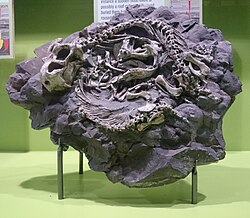Insects
| Name | Novelty | Status | Authors | Age | Unit | Location | Notes | Images |
|---|---|---|---|---|---|---|---|---|
sp. nov | Synonym | von Rosen | A Stylotermitid termite. synonym of Parastylotermes robustus | |||||
Gen et comb. nov | Synonym | (Hagen) | A protosmyline Osmylid lance lacewing | |||||
| |||
|---|---|---|---|
| +... | |||
Paleontology or palaeontology is the study of prehistoric life forms on Earth through the examination of plant and animal fossils . [1] This includes the study of body fossils, tracks ( ichnites ), burrows , cast-off parts, fossilised feces ( coprolites ), palynomorphs and chemical residues . Because humans have encountered fossils for millennia, paleontology has a long history both before and after becoming formalized as a science . This article records significant discoveries and events related to paleontology that occurred or were published in the year 1913.
| Name | Novelty | Status | Authors | Age | Unit | Location | Notes | Images |
|---|---|---|---|---|---|---|---|---|
sp. nov | Synonym | von Rosen | A Stylotermitid termite. synonym of Parastylotermes robustus | |||||
Gen et comb. nov | Synonym | (Hagen) | A protosmyline Osmylid lance lacewing | |||||
| Name | Status | Authors | Age | Unit | Location | Notes | Images |
|---|---|---|---|---|---|---|---|
Valid | A dicynodont belonging to Pylaecephalidae, living in burrows. |  | |||||
Junior synonym | Robert Broom | Junior synonym of Rhachiocephalus . | |||||
Valid | Broom | Late Permian | |||||
Valid | Broom | Late Permian | A member of Gorgonopsia. | ||||
| Name | Status | Authors | Age | Location | Notes | Images |
|---|---|---|---|---|---|---|
| Aggiosaurus [4] | Valid |
| 157 million years ago | |||
| Name | Status | Authors | Location | Images | |
|---|---|---|---|---|---|
Valid | Brown | ||||
Valid | Williston Moodie | ||||
| Taxon | Novelty | Status | Author(s) | Age | Unit | Location | Notes | Images |
|---|---|---|---|---|---|---|---|---|
| Elopteryx nopcsai [7] | Gen. et sp. nov. | Nomen dubium | Andrews | Maastrichtian | Sânpetru Formation | Either a bird or a troodontid | ||
| Hypacrosaurus altispinus [8] | Gen. et sp. nov. | Valid | Brown | Maastrichtian | Horseshoe Canyon Formation | A hadrosaurid | ||
| Procompsognathus triassicus [9] | Gen. et sp. nov. | Valid | Fraas | Norian | Löwenstein Formation | A coelophysoid | ||
| Pterospondylus trielbae [10] | Gen. et sp. nov. | Nomen dubium | Jaekel | Norian | Trossingen Formation | A coelophysoid |  | |
| Styracosaurus albertensis [11] | Gen. et sp. nov. | Valid | Lambe | Campanian | Dinosaur Park Formation | A ceratopsid |  | |
| Thescelosaurus neglectus [12] | Gen. et sp. nov. | Valid | Gilmore | Maastrichtian | Lance Formation | An ornithopod |  | |